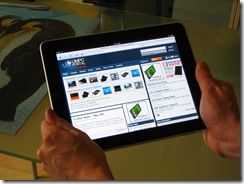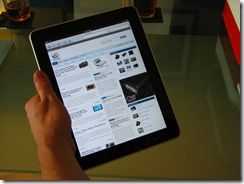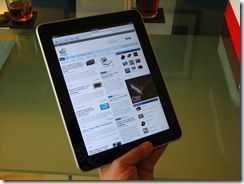 I like these guys, and not just because they’ve got a load of cool tech to play with! Shanzai.com appear to have some good contacts in the trade and a lot of experience with the market over there in the East. I’m almost in agreement with them on the ideal tablet size too. You may have a different opinion but check their article and video below before you make a decision.
I like these guys, and not just because they’ve got a load of cool tech to play with! Shanzai.com appear to have some good contacts in the trade and a lot of experience with the market over there in the East. I’m almost in agreement with them on the ideal tablet size too. You may have a different opinion but check their article and video below before you make a decision.
Tag Archive | "ipad"
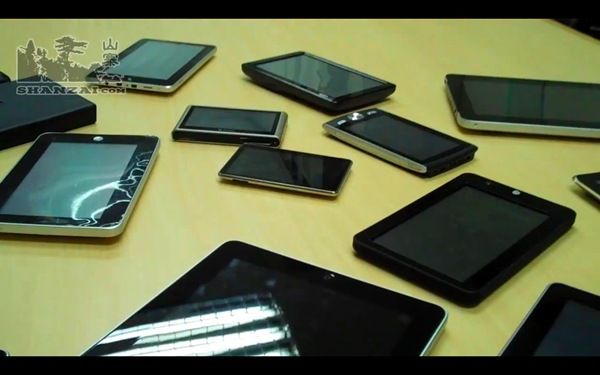
A Look at the Tablet Spectrum with Shanzai.com
Posted on 25 November 2010
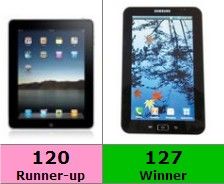
iPad vs Galaxy Tab and Dumb Ratings
Posted on 02 November 2010
I’ve got a set of 17 criteria that I’m developing for use when I review devices and I thought it would be an interesting exercise to put the iPad and the Galaxy Tab together to see which one wins on this set of criteria.
As you can see, the Galaxy Tab is the winner. End of story.
Or is it?
The totally dumb thing about this result and most other static ‘ratings’ systems is that every user approaches a device from a different angle. No-one wants every feature in equal measure and the simple reason the Tab is (only just) the winner is because it shines in the mobility and phone/video category. Some users just don’t care about that so if you take those ratings away, the iPad is the winner. The winner shown above is with ‘all things equal’ and won’t help anyone choose a device.
With that in mind I’ve created an interactive tool (hat-tip to Bryan Cryer for the javascript and Steve Litchfield for the inspiration) that puts your desires first and allows you to ‘weight’ my scores in each category.. If you aren’t interested in gaming, give it a low weighting and the scores will adjust giving you a different result. Try it…it’s fun!
Product chooser Apple iPad vs Galaxy Tab
For average viewer ratings and a chance to put your own scores in, you can use this version of the tool.
Note: The tool is still being developed and I reserve the right to refine my scores for devices.
I realise that my categorisations aren’t flawless and that my scores could also be in error so for that, I ask for your trust that I’ve refined the categories well and know my stuff when if comes to evaluating a device. If you don’t trust my reviewing skills, don’t use the tool! It would also be impractical and unworkable to break out 20 or 30 categories for each and every feature. Your suggestions during this Alpha phase are welcome though.
Here’s some more detail about the categories.
- Battery life – Working battery life, standby, always-on. Relative to size and best in class.
- Connectivity – Hard, radio connectivity. USB, BT, ports, wifi, 3g, removable storage.
- Screen quality – DPI, brightness, reflectivity, colour considered here.
- Portability – How light/small is this to carry, hand-hold. pocket.
- Storage – Based on a combination of speed and size
- Internet Experience – From WAP to desktop quality. Speed, quality, usability considered. (Connectivity is a separate consideration)
- Touch User Interface – Quality, speed, flexibility
- Processing power – Including co-processors. Compared to best of breed (at time of rating.)
- Text Input – Quality relative to size. Covers keyboard quality, size, engineering, features, flexibility, options
- Social Networking – Considers the tendency for the device to be getting the best/widest/newest selection of social networking apps
- Productivity – Includes PIM, sync, remote working and standard office apps.
- Ruggedness – Suitability for mobile work
- Application availability – How easy is it to find quality apps? Rates store, freeware, ease of finding and installing
- A/V/P experience – Combination of video playback, video connectivity, audio components, cam, webcam. A/V/P=audio, video, photo
- Gaming and entertainment – Considers 3D graphics support, CPU speed, games availability, controls, content availability, flexibility.
- Phone and Video Comms – Considers GSM voice, SMS, to multi-video video conferencing
- Location services – GPS hardware, maps, social and navigation software, apps, always on.
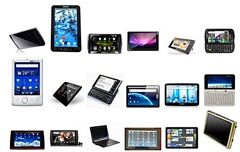
The Question Marks That Remain over Q4 Tablets.
Posted on 23 August 2010
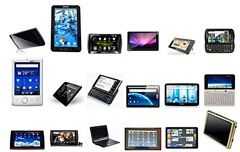 Bob Morris, head of the mobile computing division at ARM, is telling us that the Dell Streak is just the first in a line of more tablets that will arrive from various vendors in time for Christmas. I guess if anyone should have the inside info on this it’s Bob so it’s a good sign.
Bob Morris, head of the mobile computing division at ARM, is telling us that the Dell Streak is just the first in a line of more tablets that will arrive from various vendors in time for Christmas. I guess if anyone should have the inside info on this it’s Bob so it’s a good sign.
We’re clearly looking at Android as the de-facto Q4/Q1 2011 operating system solution for most of these tablets and although Froyo with Flash 10.1 is a great starting point, there’s still a significant number of big question marks that keep me sceptical. I know Nvidia, ARM and others have talked about waiting for Flash and ‘fall’ but there’s more to it than that.
How about Google Market? This is becoming more secretive than Adsense or Google’s Search algorithm and one wonders just how much money Google are now making from it. The Dell Streak got Market by being a large well-branded company that effectively designed a Android smartphone but what about the others? Every device that didn’t have marketplace/Gmail/contacts/maps so far has been highlighted as an incomplete Android product. Sideloading and 3rd party app stores aren’t the fix either. The second problem is that there needs to be a new suite of >=WVGA, large screen (mdpi-large in Android speak) apps before the first reviews start otherwise the whole Android tablet ecosystem will be tainted with poor early reviews. Bad news never seems to fade from search engine results so Google needs to re-build their app suite for mdpi-large (or even mdpi-maxi as ‘large’ only goes to 5.8 inch screens.) If Android is to have a chance at getting more productive applications in the store (as Apple have already done) Google also need to give developers a chance to prepare new versions of their apps. That can only happen if Google stimulates the developers by announcing Android 3.0 or a new phase of tablet-focused work. Give us a sign Google. Apple gave some devs a three-month head start before the product was launched. Although this was a restricted program, it was instrumental in creating a good day-1, week-1 buzz.
Link: Overview of tablets available, announced and expected
If I was an Android Tablet OEM right now I’d be considering waiting for even more than the above.
- Cheaper Cortex A9 platforms and proven Android hardware builds. Cortex A8 is still good enough but to make a serious marketing splash, dual-core A9 is now needed.
- Clarification on what the hell is going on with Chrome OS (touchscreen support looks likely)
- Concrete information about Android 3.0 (Apps suite, developer take-up, information about ARM-optimised kernels)
- IDF (Sept) and MeeGo 1.1 (Oct) (To asses competing product timescales)
Racing to get a product out for Christmas sales could be too risky and the whole ‘smart’ tablet market could suffer if a big name gets it wrong. Like you, I want products NOW but i have the feeling that the iPad will be a year old before we see any serious competitors.
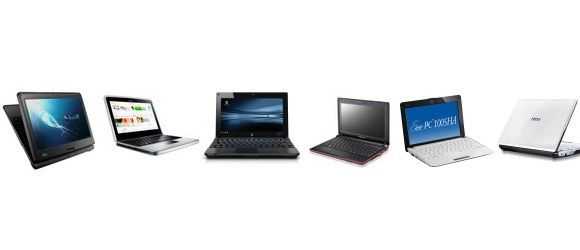
Lightweight and Mobile-Focused 3G Netbooks (And Alternatives.)
Posted on 10 August 2010
Long-gone are the days where netbooks were available at the 1KG mark. The Asus 901, Acer A150. Classic 1KG, 8.9 inch netbooks that worked well as mobile-focused PCs for getting things done almost anywhere. The EeePC 901GO was arguably one of the best mobile bargains around at the time, at least in Europe. No hard drive, sub 1KG, 3G and a great price. Oh how things have changed. All we seem to see now are 10-12 inch devices at 1.2KG or more with moving hard drives. The 800gm-1KG mark is now a specialist segment.
If you take a long hard look though and are prepared to relax your requirements a little there are a few gems hidden in there that would work well for ultra-mobile fans so I’ve taken a long look at the netbook segment, spoken to a few people (thanks Avram and Sascha) and come up with a shortlist for you. I’ve also taken a look above and below the netbook segment to give you a few alternative options.
Requirements.
Ultra Mobile devices need to be feature-rich, rugged and connected. They are the Swiss army knives of PCs that need to be ready for anything. Getting the best productivity out of any situation is important. 12 inch devices give great comfortable real-estate. 10 inch devices can be good value. 7 inch devices get right under the 1KG mark. Here are some other important features.
- No Hard Drive. Ideally you don’t want any moving parts at all in a mobile PC. Hard drives and fans can fail or get damaged and even rotating screen hinges need to be thought about very carefully. If an SSD doesn’t come as standard, I’ve looked at the upgrade possibilities.
- Bright screen. Matt finish. 10 12 inch for comfortable productivity. 7-10 inch for lighter weight.
- 3G, Wi-Fi-N and BT 2.x (but not self-upgrade unless the antenna is pre-installed)
- Long battery life (6+hrs)
- Lightweight PSU, Car Kit
- Other useful options GPS, memory upgrades. Case
- Latest CPU technology.
- Weight 1KG or less. (I’ve looked at devices up to about 1.2KG here.)
The Netbook Shortlist
Based around the 10 inch form factor, these are the gems that I’ve managed to dig out. Of the 400+ devices that I’ve searched through, these match the requirements the best. Quite amazing that there are really only this many that I would class as truly mobile devices. Note, these devices may not appear in your local market (and there may be others in your local market that I haven’t seen please lets us know if you find one.)

Summer Breaks, Products Wait. Round-Up and Outlook Q3/Q4 2010. (Pt. 1 of 2)
Posted on 05 August 2010
Don’t panic! As I return from my summer holiday (where I went with my car and returned without it another story) I feel the need to catch up quickly on what’s really been happening during the second-half of July. Again, don’t panic because if you’re on holiday yourself, it’s a quiet period and the marketing and sales teams won’t ramp-up activities until mid August. After sifting through a ton of iPhone 4 antenna stories (which resulted in some of the most boring podcast segments I have ever listened to in my life!) I’ve managed to pull a few interesting tidbits out for you. Lets go over those stories briefly and then start thinking about Q4 and the events and trade-shows that will lead up to it. This Autumn could be the busiest ever for UMPCPortal and Carrypad.
Overall it seems that everything is on hold right now. On the last MeetMobility podcast we talked about a frozen netbook market as the new dual-core and DDR3 netbook platforms filter in. One wonders whether that really means the end of the basic netbook as cpu-core and graphics specifications turn that simple market into a race for cheap, blinged-up notebooks. The same freeze is in progress with the MID, tablet and ultra mobile PC market too. The Dell Streak is going to look rather out-dated in the next round as dual-core ARM CPUs start to filter-in and if Android 3.0 launches and opens the door to new markets, different form factors and productivity applications we’ll finally see some smart and productive products. In the ultra mobile PC space the Oaktrail and Moorestown platforms have made ‘Menlow’ look rather dated. In the X86 operating system world, Android and MeeGo are still months, if not years from being mature and as we look from every angle; from the netbook market, the ultra mobile PC market, the MID market and tablet market we see the product that scares the living daylights out of every OED, the iPad. The momentum there has been simply stunning and there’s no logical way to analyze it. It’s hype, marketing, magic and fan-base that have punched through any amount of negativity to create something that people simply want. Stunning.
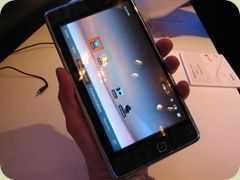 One of the products that I’m quite interested in is the Huawei S7. It’s a modern and possibly winning take on the 7 inch slate space with battery life, applications, social and fun right at its heart. OK it hasn’t got the super-slick look of the iPad but it’s one of the most complete 7 inch Android tablets i’ve seen so far. How disappointing it was to see the availability date slip right out into September. That’s a big slip and one wonders what Huawei are doing there. Did they give exclusivity to a carrier? Are they re-building the OS (Android 2.2 would be nice) or did they decide to swap out the resistive screen for capacitive? That would make sense. Unfortunately I think it’s none of the above and we’re just seeing the realities of launching a complete device into the market.
One of the products that I’m quite interested in is the Huawei S7. It’s a modern and possibly winning take on the 7 inch slate space with battery life, applications, social and fun right at its heart. OK it hasn’t got the super-slick look of the iPad but it’s one of the most complete 7 inch Android tablets i’ve seen so far. How disappointing it was to see the availability date slip right out into September. That’s a big slip and one wonders what Huawei are doing there. Did they give exclusivity to a carrier? Are they re-building the OS (Android 2.2 would be nice) or did they decide to swap out the resistive screen for capacitive? That would make sense. Unfortunately I think it’s none of the above and we’re just seeing the realities of launching a complete device into the market.
A product the might look similar to the S7 but could bring a productivity slant is the RIM Blackpad. This is RIMs rumored 9.7 inch Blackberry companion tablet. The rumor sources say it will be launched in November but I’d ignore an iPad-like or iPad-killer references. This is likely to build on RIMs core competence of secure delivery of email and messaging and I’d expect to see it with some form of keyboard to tie in with the productivity theme.
The third piece of tablet hardware news I want to mention is something we haven’t really covered much on the sites. It’s Samsungs tablet which now looks like it will be consumer focused, running Android and will be built around a 7 inch screen. Samsung are the source of the news and they’re also talking about Q3, which is now! Samsung have made some great mobile computing products in the past and I highly rate their electronic engineering skills. They have the ability to build around their own ARM-based CPU too so everything is likely to be very efficient and small. Maybe I’ll drop my Huawei order in favor of this one. It will be fun to compare it to their 2006, 7 inch UMPC, the Q1. I’m expecting it to launch at IFA in September in Berlin. I’ll be there!
Android is turning out to be the easy option when it comes to tablet operating systems now. In fact, you could almost call it the de-facto solution for anyone that doesn’t own their own mobile OS. Despite Windows 7 being a superb, stable, feature-rich and productivity-focused OS, it just doesn’t work for the consumer handheld market. The UI is plain boring and I’m sure there are plenty of people like myself that now do as much as they can on their mobile phone to avoid having to go to the desk and wake the Windows beast. Of course, a desktop-style OS is still needed for productivity but there has to be a way to combine the two for a more enjoyable working experience. As a minimum, a user interface tidy-up is badly needed to enable Windows 7 to appeal to a more consumer, social and entertainment focused customer base but unless it’s done properly, it could make things worse. Witness early Windows Mobile overlay software that leaked the original user interface once you’d got past the home screen. The same was true of Origami Experience; the software that tried to tidy-up Windows XP for tablet users. I wonder if UI Centric can do any better with their Macallan product? There’s little that can be gleened from the short video and press release they sent out describing a purpose-built tablet UI. The problem is, the look and feel might be nice but if the included applications fall short on capability, you’ll end up starting your favorite applications just as you did before and you’ll have the same old problem of tiny windows control elements and scroll-bar, double-tap and press-and-hold controls. My feeling is that no-one will be able to hide Windows 7 until the apps are re-written. (Which means never!)
In part 2 (available here) I talk about why I can legally call a device a Smartbook product when I live just 20km from the Smartbook HQ that has exclusive rights to the name in Germany, a few Mifi competitors and even more tablets. I’ll also highlight the very exciting month of September. IFA, IDF and other events will prepare us for everything that’s going to happen in Q4.
All the stories highlighted in this article appear in the center column on UMPCPortal and in our weekly update article.
New FULL RSS FEED! I’ve found a way to give you a full RSS feed. Donate to UMPCPortal and you receive a private URL which gives you access to a full, no advertising RSS feed from UMPCPortal. You’ll also get an (optional) link on the front page and a free copy of the soon-to-be-released Mobile Computing ebook written by Chippy. To donate and receive your full RSS feed, visit this page.
Forums are getting busy. Join-up and meet a great bunch of people who are also interested in mobile computing products. UMPCPortal Forums.
MeetMobility Podcast will resume in about 2 weeks time when we’re all back from summer vacation. Expect a live round-table event with JKK, Sascha and a few special guests. Stay tuned to @meetmobility on Twitter for latest announcements.
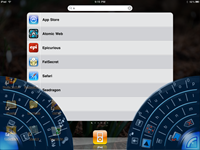
I’m Dying for Dial Keys on the iPad – Mockup Video Demo
Posted on 01 June 2010
 I was really surprised that Apple didn’t do anything “magical inch or “revolutionary inch with the iPad’s [Portal page] on-screen-keyboard. The iPhone’s was definitely revolutionary because it was probably the first truly viable OSK thanks to some intelligent software design and a capacitive screen instead of a resistive one. The iPad’s keyboard has that same inteiilgent software design, and a nice big capacitive screen. The problem is the big part. The iPad’s keyboard works well, but it really only works well if you can set it down on a desk in front of you so that you can touch type on it. If you are walking around with it in your hands, it works quite poorly for thumb typing. This fact alone makes the iPad annoying to use for typing if you don’t have something to set it down on.
I was really surprised that Apple didn’t do anything “magical inch or “revolutionary inch with the iPad’s [Portal page] on-screen-keyboard. The iPhone’s was definitely revolutionary because it was probably the first truly viable OSK thanks to some intelligent software design and a capacitive screen instead of a resistive one. The iPad’s keyboard has that same inteiilgent software design, and a nice big capacitive screen. The problem is the big part. The iPad’s keyboard works well, but it really only works well if you can set it down on a desk in front of you so that you can touch type on it. If you are walking around with it in your hands, it works quite poorly for thumb typing. This fact alone makes the iPad annoying to use for typing if you don’t have something to set it down on.
 Even since I got the iPad in my hands, I’ve been wishing for a Dial Keys-style keyboard implementation. Dial Keys, if you’ll recall, is a piece of Windows based software that was designed for touchscreen UMPCs. Dial Keys places a split radial keyboard at the corners of the device, which puts keys right in the range of one’s thumbs. If Apple allowed developers to modify the keyboard on the device, I’m sure we would have already seen something similar.
Even since I got the iPad in my hands, I’ve been wishing for a Dial Keys-style keyboard implementation. Dial Keys, if you’ll recall, is a piece of Windows based software that was designed for touchscreen UMPCs. Dial Keys places a split radial keyboard at the corners of the device, which puts keys right in the range of one’s thumbs. If Apple allowed developers to modify the keyboard on the device, I’m sure we would have already seen something similar.
I made some mockup graphics to put on the iPad just to see what Dial Keys on the iPad would look like:

Reader Post: The Disturbing Course of Mobile Technology
Posted on 17 May 2010
One of the best things about the iPad is that it is seeding great discussions, thought and experimentation. Dr. Juan Luis Chulilla Cano, Director www.onlineandoffline.net [personal blog] , Spain, sent us this article which I’m sure is going to start another good discussion. Thanks Juan.
—————————
I am not surprised at all by of the extraordinary reception given to the iPad. The exaggerated and raptured descriptions are explainable keeping in mind the huge expectations that media groups have about the iPad: if the iPad is the wonder-device which can make pay-per-content solutions acceptable for the first time in the Internet Age, then Media is forced to bomb the population with out of control hype. What I cannot totally understand is how and why the disappointment of late January, when we met the real characteristics of the device and all its shortcomings, has been magically transformed into renewed infatuation and fascination for a lot of tech bloggers, as if this disappointment has gone through a process of double-thinking.
Of course, a good number of bloggers have maintained their critical approach about iPad and what it means for the public. Indeed, the first wave of hype and uber-criticism has calmed down, and it has no sense to repeat the main criticism. Instead of it, I would rather prefer to focus on two linked topics: format variety and PC software model.
I am still amazed about how many people are, well, raptured by the SAME device. Technologically speaking, it is as if one day I get up, get out of my house and I find that most of the people I meet on the street are wearing the Mao suit. Actually, distinction is one of the most important engines of consumption, whether we talk about clothes or cars and people need to buy and use different formats of computers and Internet browsing devices, MID and the like, because they have different requirements and usage environments.
iPad nowadays is very efficient in helping their users to feel themselves different, comparing with the sheer majority of have-nots. BUT all of them are happy with ALL its characteristics and size? I just cannot accept that on the long term.
The second topic (which disturbs me a lot) is the PC software model. The astronomical PC revolution wouldn’t have been possible if all the main vendors would not accept an OS which has no limitations on what can be installed on it besides the development of the application. For sure, Windows is far from perfect (mainly because of its vulnerabilities against malware), but its unlimited software paradigm has been essential for the PC revolution. Linux shares this model, but Apple not totally: although MacOS X has no limits on what you can install on it, you cannot legally install that OS on a non-produced Apple PC. That was not bad as apple sales have been anecdotal in the last fifteen years
I do believe that all this freedom of operation has been essential for the PC revolution. A PC is much more that a browsing and text processing device, and the lack of software limitations have made possible the adaptation of the PC to a huge variety of environments and user requirements.
There, my main concern about the iPad is its tyrannical and obsessive control about what the customer may or may not do with the product they purchased, its theoretical property. As it is well known, the only legal software source for the iPad is the AppleStore, and Apple has full powers to decide what is permissible or not. Besides, recently Apple has reduced drastically the programming languages and environments that can be used for iPad development.
Some people say that this is a clear benefit for the users, because users need just “devices that work” carefree. This is connected with the prior topic (different formats for different requirements): maybe “mums” can be satisfied with such a lack of options (Cory Doctorow has a smart insight about it in his post Why I won’t buy an iPad), but a lot of users cannot be satisfied with such a proposal. The comparison with Meego is very illustrative: you can install an application in a Meego-powered device (ANY compatible device) from their future “market” (repository is an old-fashioned term these days), or from any other source. It is not going to be any restriction of language or programming environment within the capabilities of a Meego-powered device.
The amazing success of iPhone has affected Apple in a wrong and harmful way. I also find insulting that it is acceptable to treat people as minors with their rights stripped away. PCs have had a fundamental role in the process of Internet adoption for the population, with all its revolutionary consequences. But don’t forget that PC were successful before Internet adoption, and its success is totally linked with their software model.
Nowadays PCs are not the only way of accessing Internet anymore, and they aren’t going to be the main way to do that for much longer. Mobile devices are the protagonist of the next evolutionary wave of Internet, since they link Online and Offline reality in a double way; allowing Internet access anywhere, anytime, and being the basis for generating augmented reality experiences. However, if PC software model is abandoned, if we happily give up the control of our devices to the vendors, it will have negative consequences to the evolution of Internet
———————————-
Thanks again Juan. Over to you, readers.

The iPad and My European Family
Posted on 17 May 2010
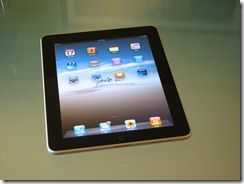 I’ve always imagined the Apple iPad to be one of the easiest purchases a Dad could make. It looks good (no more ugly laptops on the coffee table,) it can be used for multi-player games (something to bring the family together) and it can be used around the house (no more being stuck in the broom-cupboard with the family desktop.) Naturally the price can also be justified (have you seen how expensive those new coffee machines are and a BluRay player, PS3 or Wii isn’t ‘that much’ cheaper. Even smartphones are more expensive over 2 years.) With its relatively large-format text and screen, simple user interface, loungey two-handed usage and access to music, books and films from the device itself, it’s difficult to imagine the device selling to anywhere else other than the living room. Apart from the tech bloggers, apple fans, the rich, early adopters, journalists, developers, and businesspeople who also had a reason to get in early of course.
I’ve always imagined the Apple iPad to be one of the easiest purchases a Dad could make. It looks good (no more ugly laptops on the coffee table,) it can be used for multi-player games (something to bring the family together) and it can be used around the house (no more being stuck in the broom-cupboard with the family desktop.) Naturally the price can also be justified (have you seen how expensive those new coffee machines are and a BluRay player, PS3 or Wii isn’t ‘that much’ cheaper. Even smartphones are more expensive over 2 years.) With its relatively large-format text and screen, simple user interface, loungey two-handed usage and access to music, books and films from the device itself, it’s difficult to imagine the device selling to anywhere else other than the living room. Apart from the tech bloggers, apple fans, the rich, early adopters, journalists, developers, and businesspeople who also had a reason to get in early of course.
Thanks to TouchMeMobile who kindly did a short-term swap on this iPad for a Viliv S10 we’ve been testing at UMPCPortal. You’ll find the Viliv S10 articles here. (German)
I’ve had the iPad for a little over a week and have been experimenting. I compared it with an Archos 5 to see where it overlaps and testing different usage scenarios. In between, the iPad has been where it is likely to live for most people, in the living space near the TV and remote controls and among what I regard to be an average European family.
Firstly, I should say that the iPad was exactly what I expected. It looks great but is relatively heavy (especially for a tablet that doesn’t have a stand.) It is built with stylish materials that aren’t ideal for hand-holding and it has a user interface that puts all others to shame. The app-store is exciting and the battery seems to last forever. It’s clear that the touch user interface provides the main excitement though and this is where the ‘magic’ is. I liken the feeling to using an Air-Hockey game. Fluid, physical and somehow detached from the real world. It really connects the device to the user in a natural way.
The iPad was used around my home for about a week and initially, everyone was keen to use it. The game Godfinger featured heavily as did web browsing which was as fast as almost any 700gm device I’ve tested. It was used for a small amount of ‘twittering’ and email too but in the end, that usage model, and anything else that involved my private data and accounts didn’t work in the family scenario. It turns out that multiple users aren’t really well catered-for on the iPad which really goes against the grain of how I see the iPad being used.
After a few days, in a family that has a number of netbooks lying around, the iPad usage faded away. My daughter, 9, uses the netbook once or twice a week to collect and print images of her favorite Disney stars and to browse videos in Clipfish or catch up on ‘Popstars’ via the TV station’s website – all flash-driven videos. Clearly, printing and flash websites don’t work on an iPad. We’re not big electronic gamers (the Xbox is only used as a media player and DVD player and we’ve never had to tell our daughter to ‘leave that damn Nintendo alone for a minute’ ) and we don’t read e-books for hours on end (magazines, TV and books still feature heavily in our living room.) Short messaging and emails are generally done on phones (SMS still rules in Europe and there’s that personalisation issue to think about again) so I’m left wondering what the iPad would be used for. After a game of Jenga yesterday (try simulating that on the iPad!) while digital radio played in the background via our basic cable subscription, I realised that this family, despite its tech-journalist father, is just not aligned the way Steve Jobs would like and I’m imagining that the same scenario will occur right across Europe when the iPad launches leaving just the aforementioned early adopters buying.
I see where the ‘magic’ is coming from and I see that the iPad is a beautiful purchase. It’s an exciting experimental platform and connected entertainment device; I’d love to have one lying on the sofa or coffee table. Many will accuse me of not seeing the bigger picture too but, as so many people have written before, the iPad doesn’t have a unique usage case TODAY that can be used to lever a purchase TODAY. I can’t justify it.
You might think that a web site called ‘Carrypad’ is heavily pro-tablet but although we love choice, lightweight computing and sofa-surfing, we’re acutely aware of the issues of size, weight and software keyboards. Many tablets overcome the issues by being flexible in terms of connectivity or by being extremely mobile but the iPad doesn’t even do that so at 700gm / 1.5lb, I have to say that this time, Mr Jobs, you went too far in your quest for form over function and missed the mark for a general use media, web and entertainment tablet. You might have created enough marketing magic for the U.S. market and a number of ‘advanced’ European markets (UK, NL, Italy perhaps) but in the very weak Euro/Pound zone right now, where value and privacy are often concerns and where prices are very high compared to netbooks and where marketing doesn’t work as it does in the U.S, penetration isn’t going to be high.
Drop the size to 7 inch and the weight to sub 400gm, open up the connectivity so that we don’t have to treat the iPad as a PC accessory and lower the price by 200 Euro, add a docking station and I think a lot more people would be able to justify it but as it is, my EU sales predictions stay as they are. Touching the iPad didn’t really change my mind.
Notes made in first 5 minutes:
- Beautiful
- Pre-set up not needed (as this is a loan device that has been pre-configured)
- Wife’s first comment ‘too big’ followed shortly after switch-on by ‘is that for us? I want one.’
- First touch reminds me of a pinball machine.
- Web, fast!
- Email is nice
- Weight too heavy
- Slippery when dry
- Initial pics taken on camera SD card placed in netbook
Other thoughts.
- Enjoyed browsing. At last sub 10-second browsing on an ARM-based device.
- User interface a joy.
- Materials high quality but not built for use.
- Notifications system Well implemented apps need to catch up
- Flexibility Poor. Transferring files. Connectivity. Productivity. Hardly the Swiss Army Knife of tablets
- Weight poor.
- Keyboard very good technically. Few usage scenarios due to weight, lack of stand.
- Price Acceptable for a web/gaming device
- Most interesting usage scenario highly interactive musical instruments and musical experimentation.
- Battery life good
Wife’s final comment: Good for eyes, not for the back. (Followed by joke about ‘eye-pad’)
 |
| |||
 |
| |||
 |
| |||
 |
| |||
 |
| |||
 |
| |||
 |
| |||
 |
| |||
 |
| |||
 |
|



